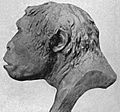Java Man facts for kids
Java Man is the popular name for some very old fossils found in Indonesia. These fossils were discovered in 1891 near the Bengawan Solo River in East Java. They are among the first known examples of an early human species called Homo erectus.
The person who found these fossils was a Dutch scientist named Eugène Dubois. He gave the discovery the scientific name Pithecanthropus erectus. This long name comes from ancient Greek and Latin words. It means "upright ape-man," which describes what scientists thought about this early human.
Contents
The Discovery of Java Man
The story of Java Man began with Eugène Dubois, a young Dutch doctor. He was very interested in human evolution. In the late 1800s, many scientists believed that humans had evolved from ape-like ancestors. Dubois wanted to find the "missing link" between apes and humans.
In 1887, Dubois went to the island of Java in Indonesia. He started looking for ancient human remains. After several years of searching, his team made an exciting discovery. In 1891, they found a tooth, a skullcap, and a thigh bone at a place called Trinil.
What Was Found?
The fossils found at Trinil were very important. The skullcap showed a brain size larger than an ape's but smaller than a modern human's. The thigh bone was very straight, suggesting that this creature walked upright. This was a big clue about how it moved.
Dubois was convinced he had found the missing link. He named his discovery Pithecanthropus erectus. This name highlighted its ape-like features (Pithecanthropus) and its ability to walk upright (erectus).
Who Was Homo Erectus?
Java Man is now known as a type of Homo erectus. This is an important species in the story of human evolution. Homo erectus means "upright man." These early humans lived a long time ago, from about 1.9 million to 117,000 years ago.
Life of Homo Erectus
Homo erectus was a very successful species. They were the first humans to leave Africa and spread across Asia. They were also the first to use fire in a controlled way. This helped them cook food, stay warm, and protect themselves from animals.
They made tools from stone, like hand axes. These tools helped them hunt animals and prepare food. Homo erectus lived in groups, which helped them survive in different environments.
Why Java Man Matters
The discovery of Java Man was a huge step in understanding human history. Before this find, there were very few fossils of early humans. Dubois's discovery provided strong evidence that humans had evolved over millions of years.
It showed that early humans walked upright before their brains became as large as ours. This changed how scientists thought about human evolution. Java Man helped prove that our ancestors were not just ape-like, but were evolving into the humans we are today.
The fossils from Java continue to be studied by scientists. They help us learn more about how early humans lived, moved, and changed over time. Java Man remains a key piece in the puzzle of human origins.
Images for kids
See also
 In Spanish: Hombre de java para niños
In Spanish: Hombre de java para niños


